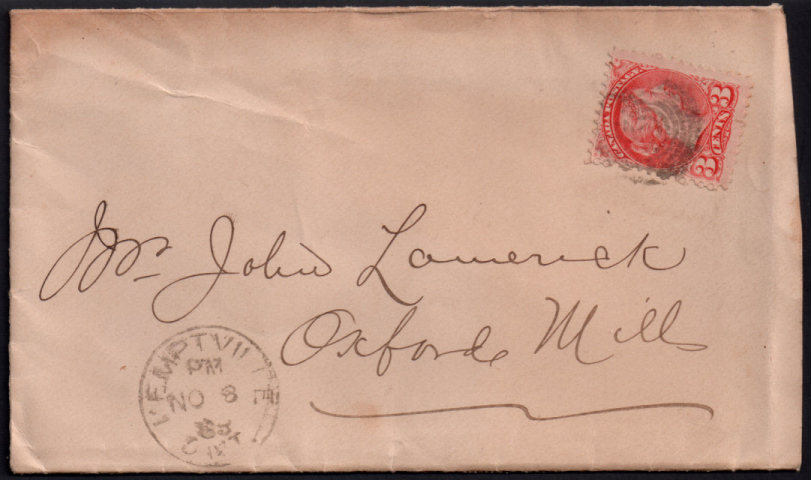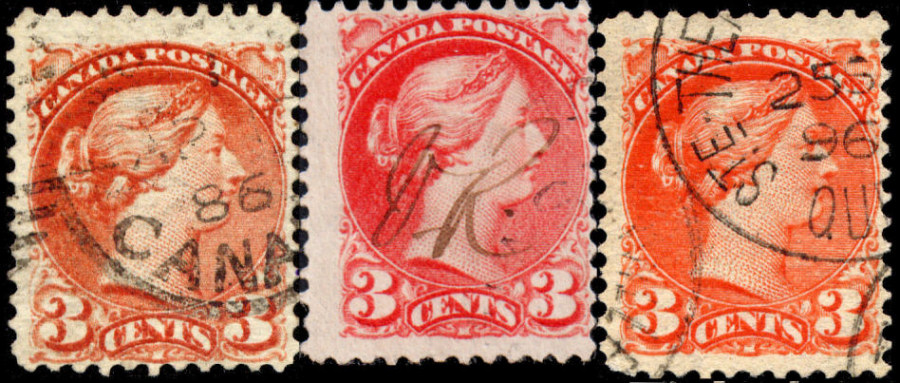BC
Departed
Rest in Peace
Vancouver, BC Canada
Posts: 836  What I collect: Worldwide USED up to the 1960's, later years from countries that came into existence after then, like Anguilla, Tuvalu and Transnistria.
What I collect: Worldwide USED up to the 1960's, later years from countries that came into existence after then, like Anguilla, Tuvalu and Transnistria.
|
Post by BC on Oct 27, 2016 16:22:09 GMT
Here is an example of the last of the Montreal printings done in 1888-89 at the Montreal Gazette newspaper building. The stamp is Scott 41a and has the distinct Rose carmine shade.  The stamps of this printing are perf 12 x 12.25. I always thought that this was the only printing that had perf 12 x 12.25 However I have found an example dated 1886, and several 1896-97. Attached is an image with a 3c rose carmine in between the other dates, with the perfs lined up to show they are the same.  Does anyone know what the earliest date for perf 12 x 12.25 is? |
|
Ryan
Moderator  Calgary, Alberta, Canada
Calgary, Alberta, Canada
Posts: 2,749  What I collect: If I have a catalogue for it, I collect it. And I have many catalogues ....
What I collect: If I have a catalogue for it, I collect it. And I have many catalogues ....
|
Post by Ryan on Oct 30, 2016 3:04:58 GMT
Based on the charts I posted in this older thread on TSF, The only use of the 12-1/4 perforation device was in late 1888. Perhaps you have an inverted slug on your copy with the 1886 postmark (they could put the 9 in upside down to read 6, or maybe it's actually from 1898 and the paired 98 slugs were both inserted upside down. Ryan |
|
BC
Departed
Rest in Peace
Vancouver, BC Canada
Posts: 836  What I collect: Worldwide USED up to the 1960's, later years from countries that came into existence after then, like Anguilla, Tuvalu and Transnistria.
What I collect: Worldwide USED up to the 1960's, later years from countries that came into existence after then, like Anguilla, Tuvalu and Transnistria.
|
Post by BC on Oct 31, 2016 18:05:49 GMT
Thank you for you comments Ryan.
The date error is a good theory. However the Rose Carmine shades are so distinct - my 1886 stamp is definitely not from that printing, even if the date is 1889.
12 x 12.25 is known also in 1897-98, even though it is not on the Shoemaker table. However, all those stamps are the distinct vermilion shade on poor paper. My stamp is on good quality paper.
Shoemaker does list a 12 x 12.25 dull orange (Sept 13, 1888) that was done just before the printers moved to the Montreal Gazette building in October (where the carmine shades were printed). It is hard to show exact colours because it depends on the scan and also the viewers monitor. My colour is closer to the dull orange, or maybe even brown orange. It is definitely not oxidized.
I suspect that the 12 x 12.25 perforation was used earlier than 1888. That is what I am trying to prove.
|
|
|
|
Post by jimjung on Nov 6, 2016 15:22:02 GMT
Bogg's (Pg 312) lists the 12 x 12 1/4 perf on Ottawa Printings from 1888-97, the earliest shade being the Dull Orange (1888). On Montreal printings after 1885 there should be a guide dot at the right side of the medallion. Ottawa printings (1888-97) also have this guide dot but not usually visible. Earlier Montreal printings should have a guide dot at the lower left under design but this could be taken out by a perf.  The postmark theory is more common than you might think. You might try to get an expert on the Small Queen period to identify the type of postmark you have on the left stamp. This may date the stamp more closely.   |
|
vggvp
**Member** 
Posts: 14 
|
Post by vggvp on Dec 18, 2016 21:30:26 GMT
Hi everybody. Compliments of the season to all.
The Small Queen perf 12 x 12.25 also comes from the 1896 and 1897 Ottawa printings.
GJP
|
|